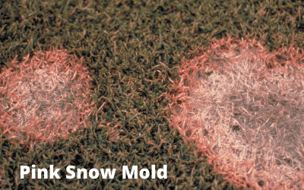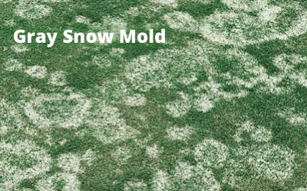What is snow mold? It's a fungus that affects cool season grasses and is found after spring snow melt.
The conditions that are favorable to snow mold is when we have heavy snow fall on cool season grasses in years when the first snow fall is on ground that is not yet frozen.

This leaves a layer for mold spores to develop and lay dormant between grass and snow. When temperatures rise and snow melts, the dormant spores will become active.

Have no fear - the effects of this disease are not extreme at all and can be remedied with some minimal raking and preventative measures. Snow mold can trigger allergy attacks as it is exposed when snow melts so we still want to be careful of this even though it’s not terribly damaging to your lawn itself.
Pink Snow Mold:
-
Appears in circular patches.
-
Patches are orange-brown to bleached light gray.
-
Fungal strands are a whitish-pink color.
-
Patches range from about 3-12 inches in diameter.
-
Grass blades are usually matted.
-
Can kill not just grass but roots as well.
-
The fungus that grows on leaf blades usually appears as whitish pink color.
Gray Snow Mold:
-
Circular patches of dead grass
-
Bleached to tan-colored areas up to several feet in diameter
-
Fungal strands are brownish-black
-
Dry grass blades are gray to silvery white
-
Turf looks water soaked and matted from up close
How to treat and prevent pink snow mold and gray snow mold:
-
Apply Nitrogen during summer and fall to avoid disease growth in winter.
-
Maintain a lower soil pH and balanced soil fertility.
-
Mow grass at low height until it goes dormant before winter
-
Lightly rake out affected areas.
-
Grass will not regrow in areas affected by Pink Snow Mold - reseeding these patches might be necessary.
-
Rake all leaves before first snow fall. Leaves left behind will create a soggy environment for spores to develop.
-
Remove snow drifts. Snow drifts hang around long and melt slower, promoting a damp environment for mold production.
Bottom Line: Like many other lawn issues - this can be prevented with a few very simple preventative measures. To greatly reduce the chance of snow mold in your lawn, call your local trusted lawn care professional for fertilization treatments. If planning to tackle the problem on your own, be persistent. Be sure to stay on the easy-at-home preventatives to reduce the chance of snow mold in your lawn.
Related Articles:
- Most Common Lawn Diseases in CT
- What Does Pythium Blight Look Like? [Disease Prevention]
- Winter Lawn Care Myths - Debunked
- Are Ticks Active During Winter?
Since 2007, Green Meadow Lawn Care has provided homeowners throughout the greater Tolland, Connecticut area with premium fertilization programs, tick control, mosquito management, seeding & aeration and tree & shrub care.
Visit our Learning Center to find out more about how our services can help you or visit our Youtube Channel to view more in our Learning Center Series.
To speak to our Customer Service Manager, please call Dave (view Dave's video bio here) with any questions. Dave has been in the industry for 30 years and is always happy to help with his expert advice.
860-870-5700



